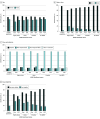Case Definition for Diagnosed Alzheimer Disease and Related Dementias in Medicare
- PMID: 39226058
- PMCID: PMC11372506
- DOI: 10.1001/jamanetworkopen.2024.27610
Case Definition for Diagnosed Alzheimer Disease and Related Dementias in Medicare
Abstract
Importance: Lack of a US dementia surveillance system hinders efforts to support and address disparities among persons living with Alzheimer disease and related dementias (ADRD).
Objective: To review diagnosis and prescription drug code ADRD identification algorithms to develop and implement case definitions for national surveillance.
Design, setting, and participants: In this cross-sectional study, a systematic literature review was conducted to identify unique International Statistical Classification of Diseases, Tenth Revision, Clinical Modification (ICD-10-CM) and prescription drug codes used by researchers to identify ADRD in administrative records. Code frequency of use, characteristics of beneficiaries identified by codes, and expert and author consensus around code definitions informed code placement into categories indicating highly likely, likely, and possible ADRD. These definitions were applied cross-sectionally to 2017 to 2019 Medicare fee-for-service (FFS) claims and Medicare Advantage (MA) encounter data to classify January 2019 Medicare enrollees. Data analysis was conducted from September 2022 to March 2024.
Exposures: ICD-10-CM and national drug codes in FFS claims or MA encounters.
Main outcomes and measures: The primary outcome was counts and rates of beneficiaries meeting each case definition. Category-specific age, sex, race and ethnicity, MA enrollment, dual-eligibility, long-term care utilization, mortality, and rural residence distributions, as well as frailty scores and FFS monthly expenditures were also analyzed. Beneficiary characteristics were compared across categories, and age-standardized to minimize confounding by age.
Results: Of the 60 000 869 beneficiaries included (50 853 806 aged 65 years or older [84.8%]; 32 567 891 female [54.3%]; 5 555 571 Hispanic [9.3%]; 6 318 194 non-Hispanic Black [10.5%]; 44 384 980 non-Hispanic White [74.0%]), there were 4 312 496 (7.2%) with highly likely ADRD, 1 124 080 (1.9%) with likely ADRD, and 2 572 176 (4.3%) with possible ADRD, totaling more than 8.0 million with diagnostic evidence of at least possible ADRD. These beneficiaries were older, more frail, more likely to be female, more likely to be dual-eligible, more likely to use long-term care, and more likely to die in 2019 compared with beneficiaries with no evidence of ADRD. These differences became larger when moving from the possible ADRD group to the highly likely ADRD group. Mean (SD) FFS monthly spending was $2966 ($4921) among beneficiaries with highly likely ADRD compared with $936 ($2952) for beneficiaries with no evidence of ADRD. Differences persisted after age standardization.
Conclusions and relevance: This cross-sectional study of 2019 Medicare beneficiaries identified more than 5.4 million Medicare beneficiaries with evidence of at least likely ADRD in 2019 using the diagnostic case definition. Pending validation against clinical and other methods of ascertainment, this approach can be adopted provisionally for national surveillance.
Conflict of interest statement
Figures

References
-
- Chronic Conditions Warehouse . 27 CCW chronic conditions algorithms. Revised February 2023. Accessed July 10, 2024. https://www2.ccwdata.org/documents/10280/19139421/ccw-chronic-condition-...
Publication types
MeSH terms
Grants and funding
LinkOut - more resources
Full Text Sources
Medical

